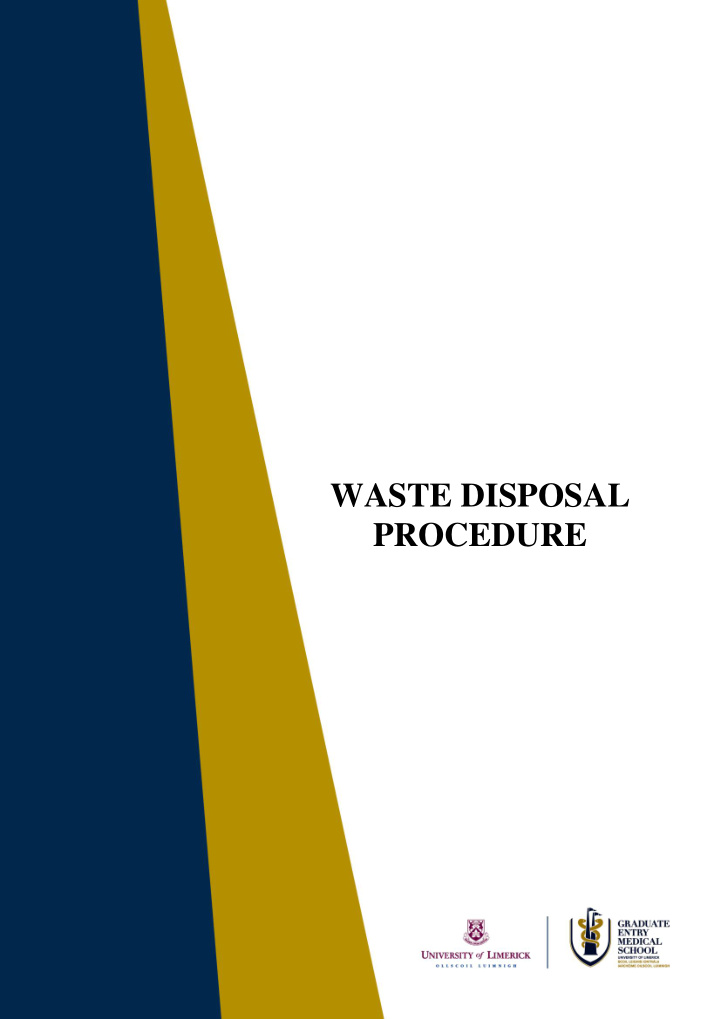



GEMSD0004.1 Clinical and Anatomical Skills Guide WASTE DISPOSAL PROCEDURE
GEMSD00013.2 Primary Responsibility: Chief Technical Officer Waste Disposal Procedure C ONTENTS 1.0 I NTRODUCTION 3 2.0 D EFINITIONS 3 3.0 R ESPONSIBILITIES 3 4.0 W ASTE D ISPOSAL STREAMS 3 5.0 W ASTE D ISPOSAL IN THE C LINICAL S KILLS L ABORATORIES 5 GEMSD00013.2 2 Last Updated: March 2014
GEMSD00013.2 Primary Responsibility: Chief Technical Officer Waste Disposal Procedure 1.0 I NTRODUCTION The correct disposal of clinical waste within the Clinical Skills Laboratories is an essential part of health and safety, infection control and general good hygiene. It is vital that all laboratory users dispose of the waste they generate in an appropriate and safe manner. Incorrect waste disposal put all users, including tutors, technical staff, students, domestic staff and waste contractors, at risk. 2.0 D EFINITIONS Clinical waste can be defined as any waste which consists wholly or partly of: Human or animal tissue; Blood or other body fluids; Excretions; Drugs or other pharmaceutical products; Swabs or dressings; Syringes, needles or other sharp instruments; which unless rendered safe may prove hazardous to any person coming into contact with it. It is also important to remember, that all wastes contaminated with clinical wastes become clinical waste themselves. 3.0 R ESPONSIBILITIES Clinical skills teaching staff are responsible for ensuring that students are informed of the correct clinical waste disposal procedure. Students must ensure that they follow the correct waste procedures at all times when in the Clinical Skills Laboratories. Clinical Skills technical staff will ensure that clinical waste is stored appropriately and collected in a timely manner by a licensed waste contractor. 4.0 W ASTE D ISPOSAL STREAMS The types of waste generated within the Clinical Skills Laboratories can be categorised as: Sharps waste Clinical waste General waste and each of these waste streams must be disposed of immediately after use. Sharps waste consists of all contaminated and non-contaminated items capable of piercing the skin and includes lancets, needles, scalpels, sutures and contaminated disposable glassware. Care should be exercised when handling sharps and resultant waste must be disposed of in designated sharps bins. Sharps bins must never be used GEMSD00013.2 3 Last Updated: March 2014
GEMSD00013.2 Primary Responsibility: Chief Technical Officer Waste Disposal Procedure for the disposal of any other type of waste as this increases the risk of needlestick injury and also leads to unnecessary increase in waste disposal costs. Clinical waste includes all other contaminated material (e.g. swabs, examination gloves, specula, catheters, etc.) and yellow clinical waste bags are available for the disposal of this type of waste. Do not dispose of general waste in these bags as it leads to unnecessary increase in waste disposal costs. Examples of general waste are packaging from consumables and paper towels and general waste bins are available for this type of waste. Under no circumstances should any sharps or clinical waste be disposed of in the general waste bin. Laboratory users should used discretion when disposing of waste. For example, a syringe on its own can be disposed of in the clinical waste bag, but a syringe with a needle attached must be disposed of in the sharps bin. While Section 5.0 has been provided as a guide to the correct waste disposal procedure, students should ask the Clinical Skills staff if in doubt as to how to dispose of particular wastes. GEMSD00013.2 4 Last Updated: March 2014
GEMSD00013.2 Primary Responsibility: Chief Technical Officer Waste Disposal Procedure 5.0 W ASTE D ISPOSAL IN THE C LINICAL S KILLS L ABORATORIES SHARPS WASTE Glass SHARPS AND ONLY SHARPS INTO THE SHARPS BIN OTHER CLINICAL WASTE Plastic NO SHARPS OR GENERAL WASTE INTO THE CLINICAL WASTE BAG GENERAL and RECYCLING WASTE PACKAGING WASTE AND NON-CONTAMINATED PAPER TOWELS ONLY. GEMSD00013.2 5 Last Updated: March 2014 ABSOLUTELY NO CLINICAL WASTE INTO THE GENERAL WASTE BIN
Recommend
More recommend